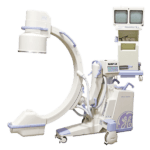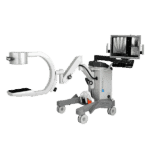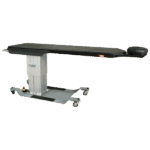Learn how to extent the life of your C-Arm battery
Plugging in the C-arm every day will extend the battery life of your C-arm and keep it operating to it’s peak capacity.
C-arms are expensive, massive pieces of equipment that require a lot of power to run. They are used in surgery, gastrointestinal labs, and pain centers around the world for diagnostic and therapeutic procedures. This article will cover basic strategies to maintain and extend the life of C-arm batteries.
First, why do C-arms have batteries? After all the C-arm is plugged into a wall outlet with unlimited electrical supply. So…why does it still need batteries to run?
C-arms require a lot of power to generate 40 – 120 KV of electricity to produce x-rays. The wall outlet provides power for the monitors only but not enough for the C-arm to generate x-rays.
The two 30 lbs. batteries generate over 100 KV of electrical power, while at the same time keeping the C-arm light enough to maneuver around the operating table and move from room to room.
As you can imagine, the batteries come in all shapes, sizes and power capacities depending on the type of C-arm used. For example, the OEC 9800 C-arm contains two batteries in its carriage and the mini-C-arm contains one battery.
Here are the specs of a typical C-arm battery for the OEC 9800 C-arm unit
- Volts: 192 Volt
- Capacity: 2.5AhWeight: 38.4 lbs.
Based on Chemistry there are two types of batteries:
- SLA or VRLA: They are acronyms for the same battery type. Sealed Lead Acid, and Valve regulated Lead-Acid Rechargeable Battery. These batteries are characterized for being maintenance free, leak proof and position insensitive. These batteries have a safety vent to release gas in case of pressure build up and they don’t need refilling of fluid. In addition, they can be installed in any position without risk of leaking battery acid
- FLA or Flooded Lead-Acid batteries are not as desirable because they are position sensitive and must sit upright to prevent leaking. They also need to be in a ventilated environment to allow gases to diffuse.
Here’s the skinny on voltage, amperage/capacity, and resistance
The flow of electrons in a circuit can be compared to flow of water in a pipe.
- Amperage is the amount of current
- Current is the flow
- Resistance is the drag
- Voltage is the pressure
Why do you need to know this?
The specs on the battery determines it’s cost and power capability. For example, a battery with over 2.5ah is more than enough to power an average C-arm. Plus, it’s less expensive than a battery with more amperage hours.
What does amperage hour (ah) mean?
For example, a C-arm with a 2.5 Ah batterycan draw 2.5 amps continuously for 60 minutes before the battery is completely drained. During a typical case, the flouro button is never on continuously for over an hour. So, 2.5 Ah is more than enough power to run a case.
Get Started
Request Pricing Today!
We’re here to help! Simply fill out the form to tell us a bit about your project. We’ll contact you to set up a conversation so we can discuss how we can best meet your needs. Thank you for considering us!
Great support & services
Save time and energy
Peace of mind
Risk reduction
How long is my C-arm batterie life?
Depends on usage and care. Brand new batteries should provide enough power for 5 years of average daily use.
What is the best way to preserve the batteries?
The c-arm should be plugged in every night after daily use. If left unplugged the C-arm will require about 2 to 4 hours to recharge in the morning. C-arms that are not used frequently should be turned on once a week to prevent over charging. You will see a “pre charge voltage Error” come on during boot up.
Is it possible to overcharge the batteries?
Yes, you can overcharge a C-arm if not used on a daily basis. Be sure to unplug and boot up the C-arm after a week or so of inactivity to avoid overcharging your system. A c-arm charge with over 250 V will generate a “PreCharge Error” message on the circuit board.
To clear the PreCharge message, you must drain the voltage in the batteries below 250 volts. First allow the system to boot up. Next, push the up and down arrows to raise and lower the C-arm column. This move should drain off some of the voltage and clear the error message.
When should the batteries be replaced?
When you see the warning message “Wait”. Typically, if the C-arm was plugged in overnight and the charge is at 70% or below then it’s time to change out the battery. To be on the safe side it’s best to change out the batteries every five years during the PM.
Are batteries easy to change?
The batteries should be changed by certified or in-house engineer.
What happens if the C-arm is not plugged in? Will the C-arm lose its charge?
Possibly, depending on the age of the batteries. The C-arm may be able to function for one case. But it’s best to err on the conservative side. Usually a C-arm not plugged in overnight will not boot up and will take about 2 or more hours to recharge.
To Recap:
Batteries provide the extra power to generate up to 100 KV of power to produce x-rays for surgical and therapeutic cases. While at the same time the batteries keep the C-arm light enough to maneuver around the room. The C-arm needs to plugged in every night to recharge the batteries. Be sure to replace the batteries every five years or sooner depending on use.
Finally, be sure to power on dormant C-arms every week or so, to prevent overcharging the batteries.
Sources
https://www.osibatteries.com/oec-9900-c-arm-battery-2pc-set-192v-2-5ah-cyclon-lead-acid
https://www.rdbatteries.com/imaging-batteries/oec/
https://batteryguy.com/kb/knowledge-base/which-deep-cycle-ah-battery
https://www.onlinebattery.co.in/blog-details/difference-between-sla-vrla-and-agm-batteries



